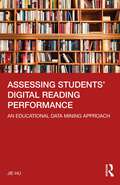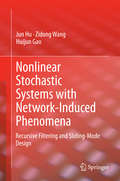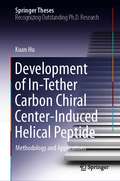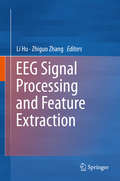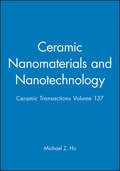- Table View
- List View
Assessing Students' Digital Reading Performance: An Educational Data Mining Approach
by Jie HUThis book provides a systematic study of the Programme for International Student Assessment (PISA) based on big data analysis, aiming to examine the contextual factors relevant to students’ digital reading performance. The author first introduces the research landscape of educational data mining (EDM) and reviews the PISA framework since its launch and how it has become an important metric to assess the knowledge and skills of students from across the globe. With a focus on methodology and its applications, the book explores extant scholarship on the dynamic model of educational effectiveness, multi-level factors of digital reading performance, and the application of EDM approaches. The core chapter on the methodology examines machine learning algorithms, hierarchical linear modeling, mediation analysis, and data extraction and processing for the PISA dataset. The findings give insights into the influencing factors of students’ digital reading performance, allowing for further investigations on improving students’ digital reading literacy and more attention to the advancement of education effectiveness. The book will appeal to scholars, professionals, and policymakers interested in reading education, educational data mining, educational technology, and PISA, as well as students learning how to utilize machine learning algorithms in examining the mass global database.
Assessing Students' Digital Reading Performance: An Educational Data Mining Approach
by Jie HUThis book provides a systematic study of the Programme for International Student Assessment (PISA) based on big data analysis, aiming to examine the contextual factors relevant to students’ digital reading performance. The author first introduces the research landscape of educational data mining (EDM) and reviews the PISA framework since its launch and how it has become an important metric to assess the knowledge and skills of students from across the globe. With a focus on methodology and its applications, the book explores extant scholarship on the dynamic model of educational effectiveness, multi-level factors of digital reading performance, and the application of EDM approaches. The core chapter on the methodology examines machine learning algorithms, hierarchical linear modeling, mediation analysis, and data extraction and processing for the PISA dataset. The findings give insights into the influencing factors of students’ digital reading performance, allowing for further investigations on improving students’ digital reading literacy and more attention to the advancement of education effectiveness. The book will appeal to scholars, professionals, and policymakers interested in reading education, educational data mining, educational technology, and PISA, as well as students learning how to utilize machine learning algorithms in examining the mass global database.
Data and Energy Integrated Communication Networks: A Brief Introduction (SpringerBriefs in Computer Science)
by Jie Hu Kun YangThe book discusses data and energy integrated communication networking technologies, including the latest research contributions in this promising area. It firstly provides an overview of data and energy integrated communication networks (DEINs) and introduces the key techniques for enabling integrated wireless energy transfer (WET) and wireless information transfer (WIT) in the radio frequency (RF) band. It then describes the ubiquitous architecture of DEINs and demonstrates the typical DEIN system and investigates the core issues in both the physical layer and the medium-access-control (MAC) layer in order to coordinate both the WIT and WET in the same RF band. Lastly, the book addresses a number of emerging research topics in the field of DEINs. It promotes joint efforts from both academia and industry to push DEIN a step closer to practical implementation. It is also a valuable resource for students interested in studying cutting-edge techniques in this field.
Handbook of Fibrous Materials, 2 Volumes: Volume 1: Production and Characterization / Volume 2: Applications in Energy, Environmental Science and Healthcare
by Jinlian HuEdited by a leading expert in the field with contributions from experienced researchers in fibers and textiles, this handbook reviews the current state of fibrous materials and provides a broad overview of their use in research and development. Volume One focuses on the classes of fibers, their production and characterization, while the second volume concentrates on their applications, including emerging ones in the areas of energy, environmental science and healthcare. Unparalleled knowledge of high relevance to academia and industry.
Handbook of Fibrous Materials, 2 Volumes: Volume 1: Production and Characterization / Volume 2: Applications in Energy, Environmental Science and Healthcare
by Jinlian Hu Bipin Kumar Jing LuEdited by a leading expert in the field with contributions from experienced researchers in fibers and textiles, this handbook reviews the current state of fibrous materials and provides a broad overview of their use in research and development. Volume One focuses on the classes of fibers, their production and characterization, while the second volume concentrates on their applications, including emerging ones in the areas of energy, environmental science and healthcare. Unparalleled knowledge of high relevance to academia and industry.
CMOS High Efficiency On-chip Power Management (Analog Circuits and Signal Processing)
by John Hu Mohammed IsmailThis book will introduce various power management integrated circuits (IC) design techniques to build future energy-efficient “green” electronics. The goal is to achieve high efficiency, which is essential to meet consumers’ growing need for longer battery lives. The focus is to study topologies amiable for full on-chip implementation (few external components) in the mainstream CMOS technology, which will reduce the physical size and the manufacturing cost of the devices.
Advanced Materials and Structural Engineering: Proceedings of the International Conference on Advanced Materials and Engineering Structural Technology (ICAMEST 2015), April 25-26, 2015, Qingdao, China
by Jong Wan HuThe ICAMEST 2015 Conference covered new developments in advanced materials and engineering structural technology. Applications in civil, mechanical, industrial and material science are covered in this book. Providing high-quality, scholarly research, addressing developments, applications and implications in the field of structural health monitoring, construction safety and management, sensors and measurements. This volume contains new models for nonlinear structural analysis and applications of modeling identification. Furthermore, advanced chemical materials are discussed with applications in mechanical and civil engineering and for the maintenance of new materials. In addition, a new system of pressure regulating and water conveyance based on small and middle hydropower stations is discussed.An experimental investigation of the ultimate strength and behavior of the three types of steel tubular K-joints was presented. Furthermore, real-time and frequency linear and nonlinear modeling performance of materials of structures contents were concluded with the notion of a fully brittle material, and this approach is implemented in the book by outlining a finite-element method for the prediction of the construction performance and cracking patterns of arbitrary structural concrete forms. This book is an ideal reference for practicing engineers in material, mechanical and civil engineering and consultants (design, construction, maintenance), and can also be used as a reference for students in mechanical and civil engineering courses.
Smart Connection Systems: Design and Seismic Analysis
by Jong Wan HuThis book introduces new smart connection systems which can be used in aseismic building design in order to control inter-story drifts and to reduce residual displacements. They are also utilized as damper devices and base isolators. The application of these systems to composite moment frame buildings will also be treated in the book. In addition,
Nonlinear Stochastic Systems with Network-Induced Phenomena: Recursive Filtering and Sliding-Mode Design
by Jun Hu Zidong Wang Huijun GaoThis monograph introduces methods for handling filtering and control problems in nonlinear stochastic systems arising from network-induced phenomena consequent on limited communication capacity. Such phenomena include communication delay, packet dropout, signal quantization or saturation, randomly occurring nonlinearities and randomly occurring uncertainties.The text is self-contained, beginning with an introduction to nonlinear stochastic systems, network-induced phenomena and filtering and control, moving through a collection of the latest research results which focuses on the three aspects of:· the state-of-the-art of nonlinear filtering and control;· recent advances in recursive filtering and sliding mode control; and· their potential for application in networked control systems, and concluding with some ideas for future research work. New concepts such as the randomly occurring uncertainty and the probability-constrained performance index are proposed to make the network models as realistic as possible. The power of combinations of such recent tools as the completing-the-square and sums-of-squares techniques, Hamilton‒Jacobi‒Isaacs matrix inequalities, difference linear matrix inequalities and parameter-dependent matrix inequalities is exploited in treating the mathematical and computational challenges arising from nonlinearity and stochasticity.Nonlinear Stochastic Systems with Network-Induced Phenomena establishes a unified framework of control and filtering which will be of value to academic researchers in bringing structure to problems associated with an important class of networked system and offering new means of solving them. The significance of the new concepts, models and methods presented for practical control engineering and signal processing will also make it a valuable reference for engineers dealing with nonlinear control and filtering problems.
Ultrasonic Nano/Microfabrication, Handling, and Driving (Emerging Materials and Technologies)
by Junhui HuUltrasonic nano/microfabrication, handling and driving is an emerging actuation technology, which utilizes ultrasonic vibration and the physical effects of ultrasonic vibration in fluids and solids to implement the fabrication, handling and driving of nano/micro scale objects. This book provides readers with the fundamentals, principles and characteristics of the ultrasonic devices for nano/micro fabrication, handling and driving, and design methods of the devices. • Introduces fundamental concepts and offers examples of ultrasonic nano fabrication, including ultrasonic nano rolling, cutting and coating methods. • Features a wealth of examples to illustrate the ultrasonic concentration and ultrasonic tweezers. • Explains the principles of ultrasonic driving of gas molecules and demonstrates their applications in high-performance gas sensor systems and metal-air flow batteries. • Teaches the principles of ultrasonic driving of microfluids and their applications in metal-air flow batteries and cooling of small solid heat sources. • Provides examples for the finite element method (FEM) modeling and computation of ultrasonic devices for nano/micro fabrication, handling and driving. • Summarizes the current and future trends in ultrasonic nano/microfabrication, handling, and driving. This book shares the advances, methods and applications of ultrasonic micro/nano fabrication techniques for entry-level and advanced readers working on nano/microfabrication, gas sensing, biological sensing, metal-air batteries, electronic component cooling, and other related areas.
Ultrasonic Nano/Microfabrication, Handling, and Driving (Emerging Materials and Technologies)
by Junhui HuUltrasonic nano/microfabrication, handling and driving is an emerging actuation technology, which utilizes ultrasonic vibration and the physical effects of ultrasonic vibration in fluids and solids to implement the fabrication, handling and driving of nano/micro scale objects. This book provides readers with the fundamentals, principles and characteristics of the ultrasonic devices for nano/micro fabrication, handling and driving, and design methods of the devices. • Introduces fundamental concepts and offers examples of ultrasonic nano fabrication, including ultrasonic nano rolling, cutting and coating methods. • Features a wealth of examples to illustrate the ultrasonic concentration and ultrasonic tweezers. • Explains the principles of ultrasonic driving of gas molecules and demonstrates their applications in high-performance gas sensor systems and metal-air flow batteries. • Teaches the principles of ultrasonic driving of microfluids and their applications in metal-air flow batteries and cooling of small solid heat sources. • Provides examples for the finite element method (FEM) modeling and computation of ultrasonic devices for nano/micro fabrication, handling and driving. • Summarizes the current and future trends in ultrasonic nano/microfabrication, handling, and driving. This book shares the advances, methods and applications of ultrasonic micro/nano fabrication techniques for entry-level and advanced readers working on nano/microfabrication, gas sensing, biological sensing, metal-air batteries, electronic component cooling, and other related areas.
Computer-Aided Design of Microfluidic Very Large Scale Integration (mVLSI) Biochips: Design Automation, Testing, and Design-for-Testability
by Kai Hu Krishnendu Chakrabarty Tsung-Yi HoThis book provides a comprehensive overview of flow-based, microfluidic VLSI. The authors describe and solve in a comprehensive and holistic manner practical challenges such as control synthesis, wash optimization, design for testability, and diagnosis of modern flow-based microfluidic biochips. They introduce practical solutions, based on rigorous optimization and formal models. The technical contributions presented in this book will not only shorten the product development cycle, but also accelerate the adoption and further development of modern flow-based microfluidic biochips, by facilitating the full exploitation of design complexities that are possible with current fabrication techniques.
Membrane Processing for Dairy Ingredient Separation (Institute of Food Technologists Series)
by Kang Hu James DicksonMembrane processing is a filtration technique in which particles are separated from liquids by being forced through a porous material, or membrane. Applied to dairy products, the separation techniques allow valuable compounds, found in milk, to be isolated for use as ingredients in food processing. A comprehensive overview of membrane separation processes, this book explores various applications such as pressure driven processes, electrical field driven processes, and concentration driven processes, for the recovery of various dairy streams and ingredients. The topics covered place emphasis on new applications, including microfiltration, ultrafiltration, reverse osmosis, electrodialysis, and pervaporation. The text also presents in-depth knowledge of the mechanisms of each membrane separation process, as well as membrane types and the equipment used in these processes. Combining their educational backgrounds and substantial industrial experience in dairy ingredients processes, the authors address cutting-edge technologies that have been thoroughly researched and have great potential to be commercialized in the near future. The book will therefore be of interest to dairy industry professionals and will serve as a source of reference material for professors and students in food science and engineering.
Membrane Processing for Dairy Ingredient Separation (Institute of Food Technologists Series)
by Kang Hu James M. DicksonMembrane processing is a filtration technique in which particles are separated from liquids by being forced through a porous material, or membrane. Applied to dairy products, the separation techniques allow valuable compounds, found in milk, to be isolated for use as ingredients in food processing. A comprehensive overview of membrane separation processes, this book explores various applications such as pressure driven processes, electrical field driven processes, and concentration driven processes, for the recovery of various dairy streams and ingredients. The topics covered place emphasis on new applications, including microfiltration, ultrafiltration, reverse osmosis, electrodialysis, and pervaporation. The text also presents in-depth knowledge of the mechanisms of each membrane separation process, as well as membrane types and the equipment used in these processes. Combining their educational backgrounds and substantial industrial experience in dairy ingredients processes, the authors address cutting-edge technologies that have been thoroughly researched and have great potential to be commercialized in the near future. The book will therefore be of interest to dairy industry professionals and will serve as a source of reference material for professors and students in food science and engineering.
Development of In-Tether Carbon Chiral Center-Induced Helical Peptide: Methodology and Applications (Springer Theses)
by Kuan HuThis book focuses on the development of stapled peptides, a novel molecular modality used to regulate aberrant intracellular protein–protein interactions (PPIs). The author designs and presents a novel helical peptide stabilization methodology by constructing a chiral cross-linker moiety, namely “chiral center induced peptide helicity (CIH)”. The book demonstrates that a precisely positioned carbon chiral center on tether can decisively determine the secondary structure of a peptide, and that the R-configured peptide is helical, while the S-configured peptide is non-helical. Further, it reports that helicity-enhanced R isomer peptides displayed significantly enhanced cell permeability and target binding affinity, as well as tumor inhibition efficiency, in comparison to S isomer peptides. The book will not only advance readers’ understanding of the basic principle of stapled peptides, but also accelerate the clinical transformation of stapled peptide drugs.
Food Safety: Rapid Detection and Effective Prevention of Foodborne Hazards
by Lan HuThis new volume, Food Safety: Rapid Detection and Effective Prevention of Foodborne Hazards, focuses on the general concepts, mechanisms, and new applications of analytical and molecular biology techniques for detecting, removing, and preventing chemical and biological hazards from food. Edited by a microbiologist and medical officer with over 20 years of laboratory and research experience in bacteriology, molecular biology, infectious disease, and food safety, and who has trained with the U.S. Food and Drug Administration (FDA), the volume provides an abundance of valuable information on food safety and foodborne hazards in our food and drink. Today, food safety is a growing concern not only of food-related professionals and policymakers, but also of the public. Foodborne hazards, including chemical and biological hazards, can cause food intoxication, infectious diseases, cancers, and other health risks. Foodborne diseases are a major public health and economic burden in both the developed and developing countries. In the United States alone, the incidence of foodborne illness is approximately 9.4 million cases with about 56,000 hospitalizations and 1,351 deaths every year. Written in an easy-to-read and user-friend style, each chapter introduces a chemical or biological hazard and addresses: What kinds of disease does the foodborne hazard cause Why is it necessary for us to study it What routes does it take to enter our food and how does it cause us to become sick How do we identify it Chapters then go on to present new technologies employed to detect, isolate, and/or identify the hazard and prevention procedures such as: (ADD BULLETS) How can the current application of new technology be used to detect the foodborne hazards How do we prevent the diseases caused by the foodborne hazards This book will be valuable to professionals and other specialists who work in food preparation, food safety, clinical laboratories, and food manufacturing industry. It will be a resource for food handling trainers as well as to anyone interested in foodborne hazards and their affective detection, reduction, and prevention strategies. This book can also serve as a important reference for more specialized courses in food safety-related courses and training programs.
Food Safety: Rapid Detection and Effective Prevention of Foodborne Hazards
by Lan HuThis new volume, Food Safety: Rapid Detection and Effective Prevention of Foodborne Hazards, focuses on the general concepts, mechanisms, and new applications of analytical and molecular biology techniques for detecting, removing, and preventing chemical and biological hazards from food. Edited by a microbiologist and medical officer with over 20 years of laboratory and research experience in bacteriology, molecular biology, infectious disease, and food safety, and who has trained with the U.S. Food and Drug Administration (FDA), the volume provides an abundance of valuable information on food safety and foodborne hazards in our food and drink. Today, food safety is a growing concern not only of food-related professionals and policymakers, but also of the public. Foodborne hazards, including chemical and biological hazards, can cause food intoxication, infectious diseases, cancers, and other health risks. Foodborne diseases are a major public health and economic burden in both the developed and developing countries. In the United States alone, the incidence of foodborne illness is approximately 9.4 million cases with about 56,000 hospitalizations and 1,351 deaths every year. Written in an easy-to-read and user-friend style, each chapter introduces a chemical or biological hazard and addresses: What kinds of disease does the foodborne hazard cause Why is it necessary for us to study it What routes does it take to enter our food and how does it cause us to become sick How do we identify it Chapters then go on to present new technologies employed to detect, isolate, and/or identify the hazard and prevention procedures such as: (ADD BULLETS) How can the current application of new technology be used to detect the foodborne hazards How do we prevent the diseases caused by the foodborne hazards This book will be valuable to professionals and other specialists who work in food preparation, food safety, clinical laboratories, and food manufacturing industry. It will be a resource for food handling trainers as well as to anyone interested in foodborne hazards and their affective detection, reduction, and prevention strategies. This book can also serve as a important reference for more specialized courses in food safety-related courses and training programs.
EEG Signal Processing and Feature Extraction
by Li Hu Zhiguo ZhangThis book presents the conceptual and mathematical basis and the implementation of both electroencephalogram (EEG) and EEG signal processing in a comprehensive, simple, and easy-to-understand manner. EEG records the electrical activity generated by the firing of neurons within human brain at the scalp. They are widely used in clinical neuroscience, psychology, and neural engineering, and a series of EEG signal-processing techniques have been developed. Intended for cognitive neuroscientists, psychologists and other interested readers, the book discusses a range of current mainstream EEG signal-processing and feature-extraction techniques in depth, and includes chapters on the principles and implementation strategies.
Smart Stimuli-Responsive Polymers, Films, and Gels: Polymers, Films, And Gels
by Liang Hu Yongfeng Gao Michael J. SerpeSmart Stimuli-Responsive Poymers, Films, and Gels Discover the most important developments in synthesis, simulation, and applications of a fascinating compound class There exist a range of natural materials that respond to environmental changes by altering their physical or chemical properties, known as stimuli-responsive polymers, these substances are responsive to light, temperature, pressure, and more. The study of these so-called “smart” polymers is essential to a range of application fields, many of which have generated cutting-edge research in recent decades. A comprehensive introduction to the subject is therefore well-timed Smart Stimuli-Responsive Polymers, Films, and Gels provides an introduction to these polymers and their applications. It includes producing these polymers through synthetic approaches, simulating their responses to different stimuli, and applying these materials in different industries and research capacities. Written to serve the requirements of advanced students and senior researchers alike, this timely work will drive years of research in this vital field. In Smart Stimuli-Responsive Polymers, Films, and Gels readers will also find: Treatment of mechanoresponsive, photoresponsive, and ionizing-radiation responsive polymers Applications in emerging fields such as sensors, biomedicine, catalysis, and more Interdisciplinary research into the properties and responses of these vital compounds Smart Stimuli-Responsive Polymers, Films, and Gels promises to become a seminal work for chemists, materials scientists, and industrial researchers seeking to incorporate these materials into a variety of industrial and research areas.
Smart Stimuli-Responsive Polymers, Films, and Gels: Polymers, Films, And Gels
by Liang Hu Yongfeng Gao Michael J. SerpeSmart Stimuli-Responsive Poymers, Films, and Gels Discover the most important developments in synthesis, simulation, and applications of a fascinating compound class There exist a range of natural materials that respond to environmental changes by altering their physical or chemical properties, known as stimuli-responsive polymers, these substances are responsive to light, temperature, pressure, and more. The study of these so-called “smart” polymers is essential to a range of application fields, many of which have generated cutting-edge research in recent decades. A comprehensive introduction to the subject is therefore well-timed Smart Stimuli-Responsive Polymers, Films, and Gels provides an introduction to these polymers and their applications. It includes producing these polymers through synthetic approaches, simulating their responses to different stimuli, and applying these materials in different industries and research capacities. Written to serve the requirements of advanced students and senior researchers alike, this timely work will drive years of research in this vital field. In Smart Stimuli-Responsive Polymers, Films, and Gels readers will also find: Treatment of mechanoresponsive, photoresponsive, and ionizing-radiation responsive polymers Applications in emerging fields such as sensors, biomedicine, catalysis, and more Interdisciplinary research into the properties and responses of these vital compounds Smart Stimuli-Responsive Polymers, Films, and Gels promises to become a seminal work for chemists, materials scientists, and industrial researchers seeking to incorporate these materials into a variety of industrial and research areas.
Emerging Nanotechnologies in Nanocellulose (NanoScience and Technology)
by Liangbing Hu Feng Jiang Chaoji ChenThis book provides expert coverage of the current state of the art in the application of nanotechnologies to cellulose research. It offers a comprehensive collection of topics including nanocellulose isolation, assembly into hierarchical structures, and advanced emerging applications. During the past decades, research in nanocellulose has advanced quickly, driven by the urgent needs for sustainability and the availability of advanced nanotechniques. Although cellulose has been investigated and used for thousands of years, the recent advances in nanotechnology have transformed our view of this natural substance. Cellulose, when present in the highly crystalline nanoscale form, can demonstrate interesting mechanical, optical, and fluidic properties that can be manipulated in designing materials with novel applications.This book contains 12 chapters. Chapter 1 focuses primarily on the fundamentals of nanocellulose, including general aspects on its structure, isolation, and characterization. Chapters 2-4 summarize the recent progress on assembly of nanocellulose into the macroscopic scale using state-of-the-art techniques. Chapters 5-13 cover the most advanced applications of nanocellulose in emerging areas, including superstrong materials, light management, electronics, energy storage, printed battery, water treatment, nanogenerator, and biomedicine. The book will appeal to upper undergraduate and graduate students through practicing researchers as a comprehensive reference on the subject of nanocellulose and its use in various fields.
Impact Damages of Braided Composites (Engineering Materials)
by Meiqi Hu Bohong GuThis book reports thermo-mechanical coupling constitutive equations and impact damage distributions of 3-D braided composite materials under impulsive loadings, in multidisciplinary fields among mechanical engineering, textile engineering and impact dynamics. The 3-D braided composite is one of the unique textile composites with integrated braided preform structure. Currently the 3-D braided composite has been rapidly applied to aerospace, automotive and medical engineering because the materials could realize the integration of material structure to manufacture complex structural parts and reduce the number of assembly connections. This book presents a thermo-mechanical coupled multiscale geometrical model of the 3-D braiding composite beams and tubes for analyzing damage mechanisms under various impact velocities. Impact deformation and damage morphologies have been described both in experimental observations with high speed cameras, micro-CT and finite element analyses. All the impact damages are shown in figures for unveiling the relationships between microstructure and failure modes. This provides a vivid way for how to design braided structures with high impact damage tolerance. The book is intended for graduate students who are interested in composite materials and mechanics, researchers investigating on impact dynamics of composite structure design, and engineers working on impact-proof structure design. The English translation of this book from its Chinese original manuscript was done with the help of artificial intelligence (machine translation by the service provider DeepL.com). A subsequent human revision of the content was done by the author.
Ceramic Nanomaterials and Nanotechnology (Ceramic Transactions Series #137)
by Michael Z. HuCeramic Transactions Volume 137 Ceramic Nanomaterials and Nanotechnology Edited by Michael Z. Hu and Mark R. De Guire This proceedings contains 21 papers from the Nanostructured Materials and Nanotechnology symposium held during the 104th Annual Meeting of The American Ceramic Society, April 28-May 1, 2003, St. Louis, Missouri. 291 pages.
Net Zero Energy Building: Predicted and Unintended Consequences
by Ming HuWhat do we mean by net zero energy? Zero operating energy? Zero energy costs? Zero emissions? There is no one answer: approaches to net zero building vary widely across the globe and are influenced by different environmental and cultural contexts. Net Zero Energy Building: Predicted and Unintended Consequences presents a comprehensive overview of variations in 'net zero' building practices. Drawing on examples from countries such as the United States, United Kingdom, Germany, Japan, Hong Kong, and China, Ming Hu examines diverse approaches to net zero and reveals their intended and unintended consequences. Existing approaches often focus on operating energy: how to make buildings more efficient by reducing the energy consumed by climate control, lighting, and appliances. Hu goes beyond this by analyzing overall energy consumption and environmental impact across the entire life cycle of a building—ranging from the manufacture of building materials to transportation, renovation, and demolition. Is net zero building still achievable once we look at these factors? With clear implications for future practice, this is key reading for professionals in building design, architecture, and construction, as well as students on sustainable and green architecture courses.
Net Zero Energy Building: Predicted and Unintended Consequences
by Ming HuWhat do we mean by net zero energy? Zero operating energy? Zero energy costs? Zero emissions? There is no one answer: approaches to net zero building vary widely across the globe and are influenced by different environmental and cultural contexts. Net Zero Energy Building: Predicted and Unintended Consequences presents a comprehensive overview of variations in 'net zero' building practices. Drawing on examples from countries such as the United States, United Kingdom, Germany, Japan, Hong Kong, and China, Ming Hu examines diverse approaches to net zero and reveals their intended and unintended consequences. Existing approaches often focus on operating energy: how to make buildings more efficient by reducing the energy consumed by climate control, lighting, and appliances. Hu goes beyond this by analyzing overall energy consumption and environmental impact across the entire life cycle of a building—ranging from the manufacture of building materials to transportation, renovation, and demolition. Is net zero building still achievable once we look at these factors? With clear implications for future practice, this is key reading for professionals in building design, architecture, and construction, as well as students on sustainable and green architecture courses.
